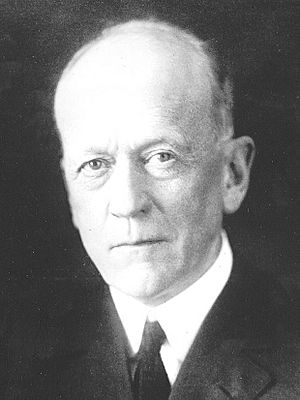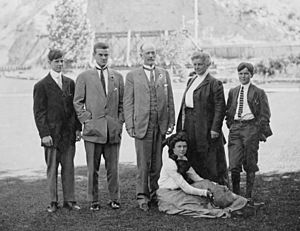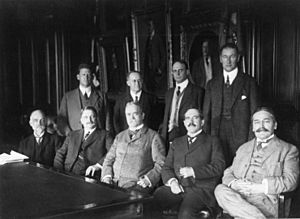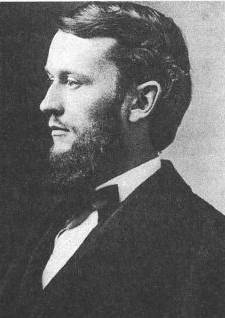Charles Doolittle Walcott facts for kids
Quick facts for kids
Charles D. Walcott
|
|
|---|---|
 |
|
| 4th Secretary of the Smithsonian Institution | |
| In office 1907–1927 |
|
| Preceded by | Samuel Pierpont Langley |
| Succeeded by | Charles Greeley Abbot |
| 3rd Director of the United States Geological Survey | |
| In office 1894–1907 |
|
| Preceded by | John Wesley Powell |
| Succeeded by | George Otis Smith |
| 4th Director of the National Advisory Committee for Aeronautics | |
| In office 1920–1927 |
|
| President | Calvin Coolidge |
| Preceded by | John R. Freeman |
| Succeeded by | Joseph Sweetman Ames |
| Personal details | |
| Born | March 31, 1850 New York Mills, New York, U.S. |
| Died | February 9, 1927 (aged 76) Washington, D.C., U.S. |
| Resting place | Rock Creek Cemetery Washington, D.C., U.S. |
| Spouses |
Lura Ann Rust
(m. 1872; died 1876)Helena Breese Stevens
(m. 1888; died 1911)Mary Morris Vaux |
| Children | 4 |
| Awards | Bigsby Medal (1895) Wollaston Medal (1918) Mary Clark Thompson Medal (1921) |
| Scientific career | |
| Fields | Paleontology |
| Institutions | Smithsonian Institution US Geological Survey |
Charles Doolittle Walcott (born March 31, 1850 – died February 9, 1927) was an American scientist who studied fossils. He was also a leader at the famous Smithsonian Institution and the United States Geological Survey. He is most famous for finding amazing, well-preserved fossils in 1909. These fossils, found in the Burgess Shale in British Columbia, Canada, included some of the oldest records of soft-bodied creatures!
Contents
Growing Up and Early Discoveries
Charles Doolittle Walcott was born on March 31, 1850, in New York Mills, New York. From a young age, he loved nature. He enjoyed collecting minerals, bird eggs, and especially fossils.
He went to different schools in the Utica area. However, he left school at age eighteen without finishing high school. This was the end of his formal education. His interest in fossils grew, and he became a collector who sold fossils.
In 1872, Walcott married Lura Ann Rust. She was the daughter of a farmer in New York. Walcott made one of his most important trilobite discoveries on her family's farm. Sadly, Lura died in 1876.
Walcott's love for fossils led him to meet Louis Agassiz from Harvard University. Agassiz encouraged him to work in paleontology. Later that year, Walcott started working as an assistant to the state paleontologist, James Hall. After two years, he joined the new US Geological Survey as a geological assistant.
A Career in Science

Walcott began his professional career by finding new places rich in fossils. These included the Walcott-Rust quarry in New York and the Georgia Plane trilobite beds in Vermont. He also sold specimens to Yale University. In 1876, he became an assistant to James Hall, the State Geologist of New York.
In 1879, Walcott joined the US Geological Survey. He quickly moved up, becoming chief paleontologist in 1893 and then director in 1894. His work focused on Cambrian rocks in the United States and Canada. His many field trips and fossil discoveries greatly helped us understand Earth's history.
In 1888, he married Helena Breese Stevens. They had four children. Walcott was elected to the National Academy of Sciences in 1896. He also led the Geological Society of America and the Philosophical Society of Washington.
In 1902, he helped start the Carnegie Institution of Washington. He held many important roles there. In 1921, he received the first Mary Clark Thompson Medal for his scientific work. He also advised then-President Theodore Roosevelt. Walcott was also interested in protecting nature and helped with conservation efforts.
Leading the Smithsonian
Walcott became the Secretary of the Smithsonian Institution in 1907. He took over after Samuel Pierpont Langley passed away. Walcott held this important position until his own death in 1927. Because of his new duties at the Smithsonian, he stepped down as director of the United States Geological Survey.
The Amazing Burgess Shale
In 1909, Walcott made his most famous discovery: fossils in the Burgess Shale. These fossils were about 508 million years old from the middle Cambrian period. The next year, in 1910, Walcott returned to the area with his sons, Stuart and Sidney.
They carefully explored the area and found the layer of rock filled with fossils. Between 1910 and 1924, Walcott went back many times. He collected more than 65,000 specimens from what is now called the Walcott Quarry, named after him. This discovery is special because it includes incredibly well-preserved soft parts of ancient creatures. It is one of the oldest fossil beds with such detailed imprints.
In 1914, Walcott married his third wife, Mary Morris Vaux. She was an artist and loved nature. She often joined him on his expeditions. Mary enjoyed studying nature and painted beautiful watercolor pictures of wildflowers during their travels in Canada.
Walcott spent a lot of time at the Burgess Shale quarry. However, he also traveled widely in other parts of the Canadian Rockies. Many of his scientific papers include amazing panoramic photos of the mountains.
Helping Aviation: The NACA

In 1914, Walcott organized a meeting in Washington, D.C. He wanted to encourage interest in aviation science and its connection to the U.S. government. This meeting led to a special law that created an Advisory Committee for Aeronautics. This committee was later named the National Advisory Committee for Aeronautics (NACA).
The NACA's job was to "supervise and direct the scientific study of the problems of flight." It aimed to find practical solutions for flying. The committee had twelve members, including experts from the Army, Navy, Smithsonian, and other scientific groups. Walcott was chosen to lead the Executive Committee.
Legacy and Impact
After Walcott's death in 1927, his fossil samples, photos, and notes were stored away. They were rediscovered in the late 1960s by a new generation of paleontologists. Since then, scientists have continued to study his findings.
Walcott's work on Ordovician trilobites in New York was also important. In the early 1990s, an amateur paleontologist named Thomas Whiteley reopened the Walcott–Rust quarry. This quarry has some of the best-preserved trilobites ever found, including ones with soft body parts.
Several places are named after Charles Doolittle Walcott to honor his contributions. These include:
- The Walcott Peak, near where he first found the Burgess Shale on Mount Burgess in Canada.
- The nearby Walcott Quarry, which holds many Burgess Shale fossils.
- The Charles Doolittle Walcott Medal, awarded every five years by the National Academy of Sciences for outstanding work in early life and Earth history.
- The World War II Liberty Ship SS Charles D. Walcott.
See also
 In Spanish: Charles Doolittle Walcott para niños
In Spanish: Charles Doolittle Walcott para niños
- Science and technology in Canada
- Walcott-Rust quarry





